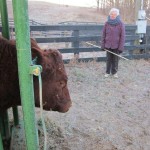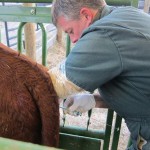Mostly cows are fun….
 ….but when it’s the middle of January and the sun isn’t quite up and the temperature is 16 degrees and there’s a wind, it’s one of those moments you question your sanity. But the timing says this is the precise moment to implant an embryo that was collected back in England six months ago, and so you wrap your scarf a little tighter and grit your chattering teeth.
….but when it’s the middle of January and the sun isn’t quite up and the temperature is 16 degrees and there’s a wind, it’s one of those moments you question your sanity. But the timing says this is the precise moment to implant an embryo that was collected back in England six months ago, and so you wrap your scarf a little tighter and grit your chattering teeth.
Wooz is holding a stick because many years ago she was run down by an Angus cow and the stick has become part of her dress code when working cows. But she would never use it. The meanest she is to a Devon is to adopt her old “school teacher’s voice” and give one a stern lecture. That was not necessary today and we were finished even before the sun came up.
 Our longtime vet, Dr. Tom Massey of Rose Hill Veterinary Services, joked he was the only one with warm hands. And for the uninitiated this is how it’s done. The frozen embryos are kept in a liquid nitrogen canister. When the cow is in the chute, and double-checked for readiness, the embryo is quickly withdrawn from the canister, inserted into warm water to thaw, and then placed in a plastic sleeve which is inside the metal tube you see here. If you look carefully, you’ll see the button at the end of the tube. When things are aligned just right, Tom pushes the plunger and the embryo is deposited in (we hope) just the right place.
Our longtime vet, Dr. Tom Massey of Rose Hill Veterinary Services, joked he was the only one with warm hands. And for the uninitiated this is how it’s done. The frozen embryos are kept in a liquid nitrogen canister. When the cow is in the chute, and double-checked for readiness, the embryo is quickly withdrawn from the canister, inserted into warm water to thaw, and then placed in a plastic sleeve which is inside the metal tube you see here. If you look carefully, you’ll see the button at the end of the tube. When things are aligned just right, Tom pushes the plunger and the embryo is deposited in (we hope) just the right place.
The egg was flushed out of the donor cow in England a week after conception. That time is noted precisely by the English embryologist and Tom implants the egg here precisely at the same minute in our cow’s cycle. And that’s why he, and we, stumble out of bed in the middle of the night in January and wish we had decided to raise hamsters…..or something.